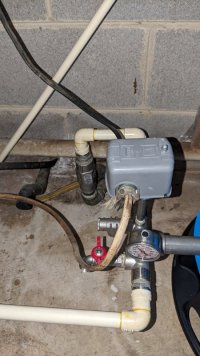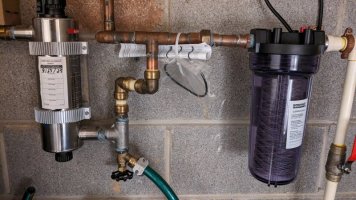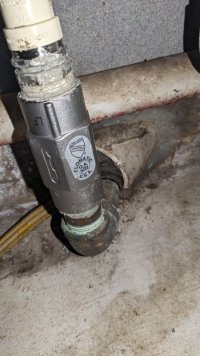I'm having an issue with my well pulling air. Last November we bought the house and it's out first with a well. By December faucets started sputtering. Our plumber found a small rusted hole in the pressure tank so we replaced it and the issue stopped. A few weeks ago it started again. In all my troubleshooting I've found that the air get introduced when the pump kicks on but is then fine. When the pump kicks on the water level in the sediment filter drops to about half and if I don't immediately purge that it from the button on the filter it goes on to cause the sputtering. There's a backflow preventer just after the well line enters the house but before the tank, I read that can be an issue? Could this just be a seasonal problem? Need help because the sputtering terrifies my daughter and she runs away anytime anyone goes near anything with water.
You are using an out of date browser. It may not display this or other websites correctly.
You should upgrade or use an alternative browser.
You should upgrade or use an alternative browser.
Pulling air on start-up
- Thread starter Tyoryn
- Start date
Users who are viewing this thread
Total: 5 (members: 0, guests: 5)
Sounds like you have the old galvanized style tank without a bladder. If so, the air maker system is working as needed, and your Air Volume Control is not. The AVC is sticking out of the tank about half way up. Has a float on the inside. The AVC is not working as that is what lets out the excess air. If it is a bladder tank that is a different animal. Picture would clue us in.
Sponsor
Paid Advertisement
Should have thought to send pics with the initial post. Here's the whole setup. Edit: forgot to mention just today I noticed the pump kicks on at 35 and sits at 40, I thought they had it at the more common setup of pump at 40 and sit at 50 or 60

Attachments
Last edited:
LLigetfa
DIYer, not in the trades
Does this "backflow preventer" have a snifter valve (looks like a tire valve)? If it does, then it is an airmaker. If it is not intentionally setup as an airmaker, then it can cause the issue. If it is setup as an airmaker, then as Cary said, you have a failed AVC.There's a backflow preventer just after the well line enters the house but before the tank, I read that can be an issue?
It's a diaphragm tank so no avc? The check valve doesn't have anything coming out of it (other side of it from the picture says flowmaster). I think it's this one. Also I think it is correctly setup to trigger drawdown 30/50, just ran a bath and this time it's holding at 50.
Attachments
Maybe Tyoryn HAD a galvanized tank, and it got replaced with a precharged tank.
Tyoryn, take a photo that shows the pipe coming from the well, the pressure switch, the pressure gauge, and at least the input of the pressure tank.
Tyoryn, take a photo that shows the pipe coming from the well, the pressure switch, the pressure gauge, and at least the input of the pressure tank.
Here's everything in 1 shot. The one black pipe closer to the camera on the left is old unused well, the one just above it with the check valve is the current well. I'm pretty sure the check valve was already there before the tank was replaced last year though it does look newer than everything else. All the PVC and everything between the 2 PVC runs is what was replaced last year. The PVC comes off camera to a ball valve shutoff then the sediment filter and UV light. The old tank was also blue like this one but taller and skinnier and was maybe fiberglass?

LLigetfa
DIYer, not in the trades
It does not look like there is a snifter so not an intentional air maker. A topside check valve is illegal in many states for a reason, mainly because a leak in the underground pipe from the well can suck in contaminated surface ground water. A leak can also suck in air which is likely the root cause for your issue.
The only place there should be a check valve is at the top of the pump down in the well.
The only place there should be a check valve is at the top of the pump down in the well.
LLigetfa
DIYer, not in the trades
A pump that fails to reach cutoff could be due to a drop in water table or a leak in the underground pipe. The check valve could have been added to mitigate water flowing back from the tank when the pump shuts off.Edit: forgot to mention just today I noticed the pump kicks on at 35 and sits at 40
So you're saying the flowmaster just after the pipe comes through the wall shouldn't be there and could be making the leak more of an issue? Or if we fix the leak then it's fine being there? Any way to easily locate an underground leak?
I tried a troubleshooting step I saw online, close shutoff between tank and filter, shut off pump then watch pressure. It stayed steady for over 30 min. The article said this was to check if the check valve failed but unsure if they meant one at the pump or the one at the inlet/tank.
Edit: could the issue only presenting when it's cold outside be a sign of an underground leak? Like the cold making metal shrink making it leak but in summer thermal expansion stops the leak?
I tried a troubleshooting step I saw online, close shutoff between tank and filter, shut off pump then watch pressure. It stayed steady for over 30 min. The article said this was to check if the check valve failed but unsure if they meant one at the pump or the one at the inlet/tank.
Edit: could the issue only presenting when it's cold outside be a sign of an underground leak? Like the cold making metal shrink making it leak but in summer thermal expansion stops the leak?
LLigetfa
DIYer, not in the trades
Yes, but I cannot claim to be the originator of that. It has been written in law long before. There is a sticky thread on that in this pump section.So you're saying the flowmaster just after the pipe comes through the wall shouldn't be there and could be making the leak more of an issue?
To narrow down where the leak might be, lift the pump up off the pitless (assuming there is a pitless) and pressure test each side. Sometimes it is the pitless itself so replace the O-ring if both sides test fine.
BTW, a top side check valve can cause the check valve in the pump to fail. A check valve relies on back pressure for it to seal. When the lower check valve fails to seal, the weight of the water creates suction above the water line that then draws in air and/or contaminated surface water.
Bannerman
Well-Known Member
No, the check valve should not be there. There should be only one check valve in the system, that is, built directly within the pump or an external CV directly connected to the pump's outlet fitting.Or if we fix the leak then it's fine being there?
So am I wrong in thinking the following order of attempted fixes:
1) remove top side check valve and hope it's just that easy of a fix
2) have someone pull up the pump to check the lower check valve and replace o rings
3) pressure test from each side of the well pipe to find leak
1) remove top side check valve and hope it's just that easy of a fix
2) have someone pull up the pump to check the lower check valve and replace o rings
3) pressure test from each side of the well pipe to find leak
Is there much of a chance the pump doesn't have one internally or at the outlet and the top side check is the only one in the system? I'm sure that's some haphazard handyman design but stranger things have happened.No, the check valve should not be there. There should be only one check valve in the system, that is, built directly within the pump or an external CV directly connected to the pump's outlet fitting.
3/4"Is that 1/2 inch CPVC (5/8 inch OD) between the check valve and the pressure tank? Or is that 3/4 CPVC?
Nice photos.
You can just remove the guts of the check valve and put it right back in to work like a piece of pipe. But the check valve will need to be removed before you can determine if there is a leak down the well or underground. After removing the check valve, close off water to the house. If then the pressure drops over time, there is a hole somewhere prior to the check valve you removed.
Oh! I think I'm going to try that, checks for 2 possible problems at once.You can just remove the guts of the check valve and put it right back in to work like a piece of pipe. But the check valve will need to be removed before you can determine if there is a leak down the well or underground. After removing the check valve, close off water to the house. If then the pressure drops over time, there is a hole somewhere prior to the check valve you removed.
Ground water levels change for various reasons. Higher water in the summer and lower in the winter is less common.
Take a look at the https://dnr.mo.gov/document-search/why-groundwater-levels-change-pub2884/pub2884 western plains graph.
Take a look at the https://dnr.mo.gov/document-search/why-groundwater-levels-change-pub2884/pub2884 western plains graph.
Similar threads
- Replies
- 4
- Views
- 284
- Replies
- 9
- Views
- 822
- Replies
- 0
- Views
- 251
- Replies
- 6
- Views
- 861



